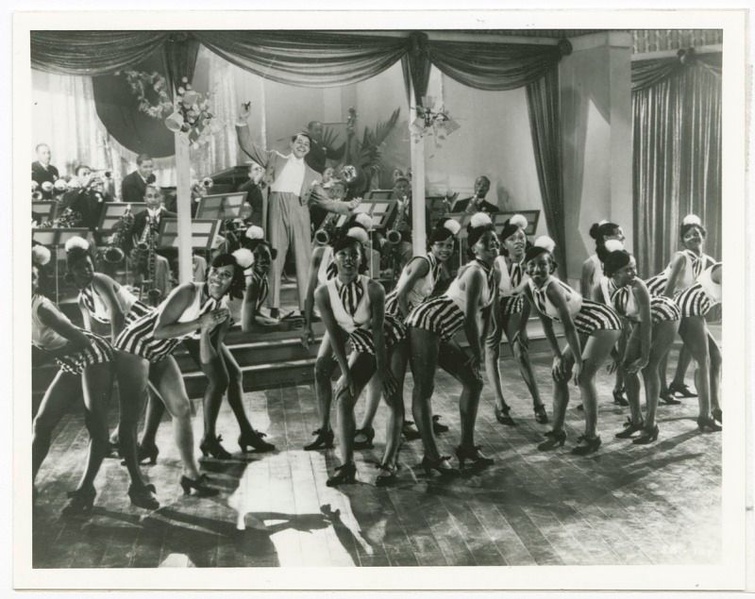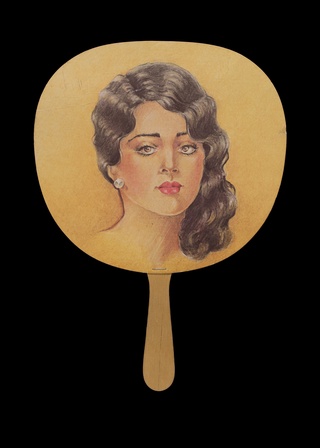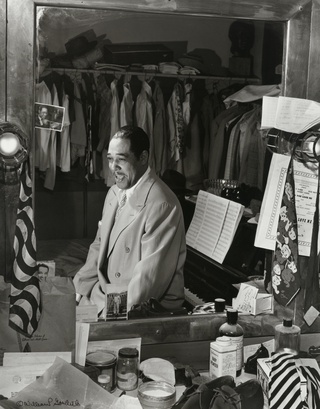A Tale of Two Harlems: The Legacy of Jazz and Racism at the Cotton Club
By Colony Little•July 2022•8 Minute Read

Unknown, Print of Cab Calloway with his band and dancers onstage at the Cotton Club, 1937, printed 1970s. Smithsonian Institution. A photograph of Cab Calloway and his dancers at the Cotton Club in Harlem circa 1937.
The Cotton Club launched the careers of legendary African-American actors, musicians, and dancers who personified the Jazz Age. But the club’s legacy of racism and discrimination undermined the progressive cultural shifts created by African-Americans during the Harlem Renaissance.
Introduction
At the height of the Harlem Renaissance, synergy among art, activism, literature, and music catalyzed a perfect cultural storm. Harlem’s heady nightclub scene was the locus. Among the dozens of venues that lined the streets of Lenox Avenue, The Cotton Club is famous for fostering the careers of musicians who launched the Jazz Age. However, the social dynamics that perpetuated divisions between African-Americans and white patrons of Harlem’s entertainment district during this era of creative growth are often overlooked. The Cotton Club in particular was notorious for reinforcing Jim Crow segregation, colorism, classism, and violence. Yet the legacy of this musical hothouse remains enshrined in an armor of glitz and glamor.
Harlem and the Great Migration
Thousands of African-Americans moved north during the Great Migration. Harlem became the destination for new arrivals to New York, where writers, musicians, artists, and performers were cultural crusaders for Black advancement. Publications like Crisis Magazine, helmed by W.E.B DuBois, chronicled the events that shaped Black life in America. Slowly percolating throughout this burgeoning movement was Harlem’s electrifying jazz scene. The clubs, speakeasies, and juke joints that dotted Lenox and Seventh Avenues characterized the nightlife. Places like Smalls’ Paradise, the Lafayette Theatre, Connie’s Inn and the Savoy Ballroom attracted Black audiences to their revues, comedy shows, and concerts. However, it was the Cotton Club that attracted curious white patrons with an exoticized idea of Harlem.
Catering to the White Gaze
The Cotton Club opened in 1923 after a defunct supperclub named Club Delux, established by boxer Jack Johnson, was bought by Owen Madden.1 Madden expanded the space and transformed the club’s brand through overtly offensive imagery that included jungle and antebellum motifs like bolls of cotton and Black caricatures. These derogatory elements appeared in set designs, advertisements, menus, and programs.2 3
The Cotton Club’s Unrivaled Musicians
The entertainment at the Cotton Club included legendary musicians like Duke Ellington, Cab Calloway, and Louis Armstrong. These jazz greats presided over the house bands, accompanied by a chorus of Black female dancers called The Cotton Club Girls who were carefully chosen for their fair complexions.
All of the performers at the Cotton Club were Black, allowing the club to claim the veneer of representation and cultural authenticity. In reality, the Cotton Club had a strict policy of only patronizing white guests and expressly prohibiting Black customers. Colorism among the performers kept male comedians, tap dancers, and vaudeville acts dark skinned, while chorus girls and female singers were light skinned.
Black Intellectualism and the Harlem Renaissance
Running along parallel cultural tracks, entertainers and the Black literati created different perceptions of Black culture during the Harlem Renaissance.
“The New Negro” Movement, Intellectuals, and Advocacy
In 1925, writer Alain Locke edited a special issue of the magazine Survey Graphic called “Harlem: The Mecca of the New Negro,” a cultural syllabus for the Harlem Renaissance. A cover portrait of tenor Roland Hayes set the celebratory tone. Inside, Locke compiled exemplars of Black cultural achievement that challenged reductive, racist stereotypes of Black life. The magazine included Renaissance writers and poets like DuBois, Claude McKay, and Jean Toomer, as well as artwork by Aaron Douglass.
In his introductory essay, Locke expressed both urgency and optimism, imploring his readers to seize this moment of change and relinquish the veil of paternalism, violence, and racism that relegated African-Americans to perpetual servitude. He argued, “[F]or generations in the mind of America, the Negro has been more of a formula than a human being—a something to be argued about, condemned or defended, to be ‘kept down,’ or ‘in his place,’ or ‘helped up,’ to be worried with or worried over, harassed or patronized, a social bogey or a social burden.” Locke built a case for abandoning charity in favor of justice. He warned his readers that seeking justice has its dangers: “This is indeed a critical stage of race relationships because of the likelihood, if the new temper is not understood, of engendering sharp group antagonism and a second crop of more calculated prejudice. In some quarters, it has already done so.”4 By Locke’s measure, the Cotton Club’s iconography, segregationist practices, and colorist staffing decisions supported the racist, paternalistic, reductive mindset that the New Negro worked to eradicate.
Intellectual Pushback Against the Cotton Club
In his book The Big Sea, Langston Hughes wrote, “White people began to come to Harlem in droves. For several years they packed the expensive Cotton Club on Lenox Avenue. But I was never there, because the Cotton Club was a Jim Crow club for gangsters and monied whites.” But as the legacy of the Cotton Club grew over time, its not-so-subtle stratifications of race and class were ignored in favor of promoting the musical legends and venerable talent that performed at the nightclub.
The Savoy Ballroom: A Harlem Club for Harlemites
The Savoy Ballroom opened on Lenox Avenue in 1926, two blocks from the Cotton Club. It was an opulent dance club known for crystal chandeliers, art deco columns, and mirrored, marbled stairways. The stairs led to a raised double bandstand and a sprung dance floor called the track that traversed the entire length of the block-long club.5 The corner of the dance floor near the bandstand was called the Cats’ Corner and was reserved for the best Lindy Hoppers. Unlike the Cotton Club, however, the Savoy was an integrated establishment that welcomed both Black and white customers. As such, it rightly touted itself as “The World’s Finest Ballroom.”6
Unknown, Savoy Ballroom Floor Plan, 1926-1958. Schomburg Center for Research in Black Culture, Manuscripts, Archives and Rare Books Division, The New York Public Library.
The Persistent Popularity of the Cotton Club Brand
Despite the Savoy Ballroom’s popularity, the Cotton Club is remembered as one of Harlem’s most famous nightclubs. Its legacy has captured the imaginations of writers and filmmakers alike.
A year after Alain Locke proclaimed Harlem the Mecca of the New Negro, Rudolph Fisher’s article “The Caucasian Storms Harlem” shed light on the voyeuristic, detached fascination with Black culture as filtered through a white lens.7 These perceptions carried the Cotton Club for decades, adding a patina of cultural legitimacy to its illicit beginnings.
As late as 1984, Francis Ford Coppola’s pop rendering of the Cotton Club in his film of the same name stars Richard Gere as a white coronet player. In reality, the Cotton Club had no white performers. Due to alleged budgetary shortfalls, writers dramatically cut elements from the film’s original script that focused on the parallel storyline of tap dancer Sandman Williams, played by actor Gregory Hines. The initial release of the movie also focused on white gangster subplots surrounding illegal liquor distribution. These cinematic flourishes overshadowed the racist culture within the original club and also downplayed the caliber of Black talent it nonetheless supported. Some of these shortfalls were corrected in a re-edit of the film, released in 2019.8
A Demystified Legacy
After the Harlem Riot of 1935, the Cotton Club was forced to close. It later reopened in Midtown at Broadway and 48th Street. Ironically, the club began to admit Black customers at the new location. Copycat clubs sprouted up across the country, seeking to emulate the original mystique of the Cotton Club while effectively obscuring its problematic racial politics. This erasure prevents a deeper examination into the discriminatory attitudes and racist systems that profited from segregation and exploitation. By reserving Black talent for white audiences while excluding Black customers, the Cotton Club undermined the economic, social, and cultural gains African-Americans achieved during the Harlem Renaissance. Within the history of the Cotton Club is an important lesson in how cultural memory is recorded and, specifically, who remembers it.
Colony Little (she/her/hers) is a Raleigh-based freelance writer and the creator of Culture Shock Art, a site dedicated to the synergies among art, music, and design. As a Black woman with familial ties to the South, Little presently writes with a particular focus on amplifying the artistic voices of Black creators who are influenced by and create work in the American South. Freelance writing credits include Artnet News, ARTnews, The Art Newspaper, ARTS.BLACK, CARLA, Hyperallergic, W Magazine, and Walter Magazine in North Carolina. Little was a 2020 recipient of the Andy Warhol Foundation Arts Writers Grant.
Citations
Bauer, Patricia. “Cotton Club.” Britannica, https://www.britannica.com/topic/Cotton-Club. Accessed 4 May 2022.
Winter, Elizabeth. “Cotton Club of Harlem 1923 To 1935.” Black Past, December 2007, https://www.blackpast.org/african-american-history/cotton-club-harlem-1923/. Accessed 4 May 2022.
King, Samantha. Cotton Club: “The Staple Of Black Talent In The Harlem Renaissance.” NYS Music, 8 June 2021, https://nysmusic.com/2021/06/08/the-cotton-club-the-staple-of-black-talent-in-the-harlem-renaissance/. Accessed 5 February 2023.
Locke, Alain. “Enter the New Negro.” Survey Graphic, March 1925, https://nationalhumanitiescenter.org/pds/maai3/migrations/text8/lockenewnegro.pdf. Accessed 4 May 2022.
“The Savoy Ballroom, Harlem NY.” Welcome to Harlem, 22 December 2010, https://welcometoharlem.com/the-savoy-ballroom/. Accessed 4 May, 2022.
Moon, Clay. “The Savoy Ballroom: Rejecting Black Exoticism Through Community-Driven Design.” McGill University, 10 June 2021, https://blogs.mcgill.ca/race-space/2021/06/1302. Accessed 4 May 2022.
Fisher, Rudolph. “The Caucasian Storms Harlem,” The American Mercury 11, 1927, pp. 393–398, https://www.amherst.edu/system/files/media/1973/Fisher%2520-%2520The%2520Caucasian%2520Storms%2520Harlem.pdf. Accessed 4 May 2022.
Henderson, Odie. “The Cotton Club Encore.” Roger Ebert.com, 7 October 2019, https://www.rogerebert.com/reviews/the-cotton-club-encore-movie-review-2019. Accessed 4 May 2022.
Colony Little (she/her/hers) is a Raleigh-based freelance writer and the creator of Culture Shock Art, a site dedicated to the synergies among art, music, and design. As a Black woman with familial ties to the South, Little presently writes with a particular focus on amplifying the artistic voices of Black creators who are influenced by and create work in the American South. Freelance writing credits include Artnet News, ARTnews, The Art Newspaper, ARTS.BLACK, CARLA, Hyperallergic, W Magazine, and Walter Magazine in North Carolina. Little was a 2020 recipient of the Andy Warhol Foundation Arts Writers Grant.


